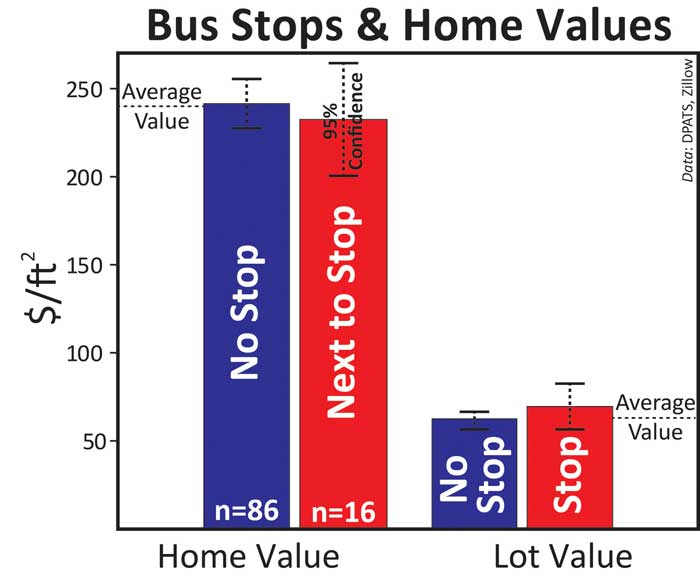
Single-family home values on E. 23rd Ave. between Colorado Blvd. and Syracuse St., excluding commercial intersections.
I shouldn’t be surprised that folks have strong opinions about anything affecting their neighborhood—but I was taken aback by controversy over a new bus line recently installed near our house. While some neighbors jumped for joy at the prospect of an easier commute, others circulated protest petitions. The impacts on traffic, parking, litter and privacy were discussed, but the greatest worries were safety, noise and property values. These are not uncommon concerns and as a result, studies have been done on the impact bus lines have on residential neighborhoods. Let’s review the data to see what the impacts are.
Safety: Adding bus lines does not add significant accident risk for cyclists, pedestrians or children playing in a neighborhood. In fact, for buses the number of accidents per mile traveled is astonishingly small compared to all other passenger vehicles. Buses account for less than 1 percent of the injuries, fatalities and property damage caused by all U.S. drivers.
Noise: The impact of buses on noise pollution is hard to measure because the impact is a function of many factors: duration, intermittency and peak levels of noise, and its relationship to background noise. Noise hazards are also hard to quantify unless one knows how many cars are effectively “removed” from the road by riders of the bus. Regardless, using any metric, even a new diesel bus emits more noise pollution than does a passenger car/truck/SUV. However, natural gas and electric buses are quieter—emitting about the same or less noise than most passenger vehicles.
$$$: Studies from outside of Colorado indicate that adding a new local bus line (i.e., not an express or rapid-transit bus line) either has a negative or no impact on home values. To get some locally comparable data, I studied the impact of RTD’s Route 20 in Denver’s Park Hill neighborhood. Proximity to the bus line does not correlate with increased or decreased property values. Nor does having a bus stop in front of a house correlate with significantly lower property values.
Traffic: Because most buses in Colorado are run by a municipality or a partner agency, integrated route planning occurs before bus lines are added to streets. This minimizes the addition of unnecessary buses and reduces their impacts on traffic. Outside of urban cores, adding buses does not cause significantly greater traffic delays.
Litter: “Common sense” suggests that new bus stops bring more litterbugs to an area and concentrate the activities of existing litterbugs. Ironically, I found no quantitative data to support this correlation. That said, maybe this hypothesis (more buses = more trash) is so obvious, nobody has ever tested it.
Parking: Data on the parking impact of bus service is equivocal. During installation of a bus line, street parking is sometimes removed to create bus stops. At the same time, in urban cores and along key arteries, buses can free up parking by reducing the number of cars requiring parking spaces.
Crime: In some cases, installation of a bus line correlates with changes in the distribution of already-existing crime types in a neighborhood (e.g., vandalism). But in residential neighborhoods most data suggests that the presence of a bus line does not correlate with or cause an increase in crime. Nor do homes closer to bus lines typically experience more crime.
Buses are our most cost-effective, flexible and common form of public transportation. They carry more passengers than all other modes of public transportation combined. Nonetheless, they can have a negative impact by increasing litter, noise and street wear. Some types of bus lines reduce home values, whereas others increase them. Buses typically have minimal to no net impact on safety, traffic, parking or crime. On a per-passenger-mile basis their impact on air quality, energy use and greenhouse gas production is often either negligible or an improvement.
The data above are only a starting point. Bus routes bring indirect economic benefits to cities and adjacent neighborhoods. They have social benefits such as connecting residential areas with entertainment areas. They provide accessibility for seniors, students, the disabled, those without a car, and those who might be partaking. Such impacts are more difficult to measure but merit a spotlight in community discussions about transportation planning.
For now, I hope this summary gives you some data to help shape your opinions. My 3-year-old, for one, is eager for me to take him on the new “very very big big” bus. James W. Hagadorn, PhD, is a scientist at the Denver Museum of Nature & Science.
Suggestions and comments welcome at jwhagadorn@dmns.org. James W. Hagadorn, PhD, is a scientist at the Denver Museum of Nature & Science. Suggestions and comments welcome at jwhagadorn@dmns.org.

If a bus stop has just been installed outside your house in a residential area wouldn’t your house value be reduced?
Gary: There is no data that suggests that a bus stop would decrease your home’s value. Depending on the type of bus line, style of home, and nature of your neighborhood, some studies have shown increases in value or no change in value. Hope this helps! James